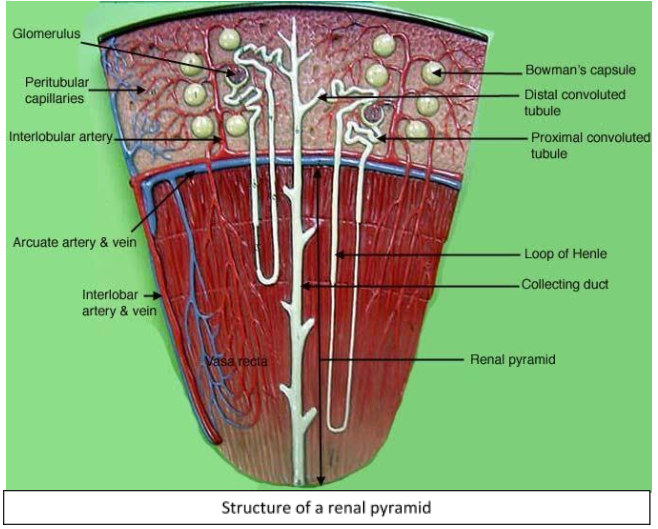
The collecting ducts in the kidney converge to form
A. Pyramid
B. Calyx
C. Pelvis
D. Columns of Bertin
Answer
480.3k+ views
Hint: Distal tubules from different nephrons join to the collecting ducts. Collecting ducts then join to form a cone-shaped structure of medulla into which the filtrate is released.
Complete answer: A kidney has an outer cortical portion and an inner medullary portion. The functional unit of the kidney is the nephron.
A nephron has a few parts: Bowman’s capsule, glomerulus, proximal tubule, Henle’s loop, distal tubule.
1. Distal tubules from different nephrons join to form a collecting duct.
2. Usually, the capsule and glomerulus portion of nephrons remain in the cortex while some Henle’s loops and collecting ducts move into the medullary portion.
3. Several collecting ducts unite together to form medullary rays. These open into the medulla of the kidney.
4. The medulla consists of a few cone-shaped or pyramid-shaped masses called medullary pyramids which project into the calyces (minor calyx and then to major calyx).
These structures are also called renal pyramids.

So, the correct answer is A. Pyramid.
Note: The renal pyramids are connected to the calyces and the calyces then join the renal pelvis. From the renal pelvis, the ureter carries away the excretory fluid to the urethra. Their urine is stored temporarily before excretion.
Complete answer: A kidney has an outer cortical portion and an inner medullary portion. The functional unit of the kidney is the nephron.
A nephron has a few parts: Bowman’s capsule, glomerulus, proximal tubule, Henle’s loop, distal tubule.
1. Distal tubules from different nephrons join to form a collecting duct.
2. Usually, the capsule and glomerulus portion of nephrons remain in the cortex while some Henle’s loops and collecting ducts move into the medullary portion.
3. Several collecting ducts unite together to form medullary rays. These open into the medulla of the kidney.
4. The medulla consists of a few cone-shaped or pyramid-shaped masses called medullary pyramids which project into the calyces (minor calyx and then to major calyx).
These structures are also called renal pyramids.

So, the correct answer is A. Pyramid.
Note: The renal pyramids are connected to the calyces and the calyces then join the renal pelvis. From the renal pelvis, the ureter carries away the excretory fluid to the urethra. Their urine is stored temporarily before excretion.
Recently Updated Pages
What percentage of the area in India is covered by class 10 social science CBSE

The area of a 6m wide road outside a garden in all class 10 maths CBSE

What is the electric flux through a cube of side 1 class 10 physics CBSE

If one root of x2 x k 0 maybe the square of the other class 10 maths CBSE

The radius and height of a cylinder are in the ratio class 10 maths CBSE

An almirah is sold for 5400 Rs after allowing a discount class 10 maths CBSE

Trending doubts
The Equation xxx + 2 is Satisfied when x is Equal to Class 10 Maths

Why is there a time difference of about 5 hours between class 10 social science CBSE

Change the following sentences into negative and interrogative class 10 english CBSE

Write a letter to the principal requesting him to grant class 10 english CBSE

Explain the Treaty of Vienna of 1815 class 10 social science CBSE

Write an application to the principal requesting five class 10 english CBSE




